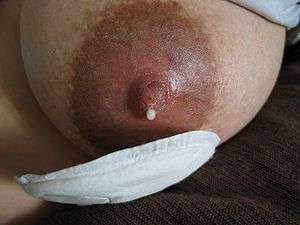Nipple discharge
Nipple discharge is the release of fluid from the nipples of the breasts. Abnormal nipple discharge may be described as any discharge not associated with lactation.[2] The nature of the discharge may range in color, consistency and composition, and occur in one or both breasts. Although it is considered normal in a wide variety of circumstances it is the third major reason involving the breasts for which women seek medical attention, after breast lumps and breast pain. It is also known to occur in adolescent boys and girls going through puberty.
| Nipple discharge | |
|---|---|
 | |
| Milk coming from the nipple | |
| Specialty | Gynecology |
| Types | Physiologic, pathologic[1] |
Nipple discharge may be milk as a result of pregnancy or hormone problems such as high prolactin.[1] Or it may be due to an underlying breast disease.[1] About 3% of cases are due to cancer.[1]
Signs and symptoms
Nipple discharge refers to any fluid that seeps out of the nipple of the breast. Discharge from the nipple does not occur in lactating women. And discharge in non-pregnant women or women who are not breastfeeding may not cause concern. Men that have discharge from their nipples are not typical. Discharge from the nipples of men or boys may indicate a problem. Discharge from the nipples can appear without squeezing or may only be noticeable if the nipples are squeezed. One nipple can have discharge while the other does not. The discharge can be clear, green, bloody, brown or straw-colored. The consistency can be thick, thin, sticky or watery.[3]
Treatment
Initially, an evaluation of malignancy is always indicated. If no abnormality is found, then a surgical duct excision may resolve the symptoms. Treatment also depends on whether single-duct or multiple-duct discharge is present, and whether the symptoms of nipple discharge are distressing to the patient. In some cases, there may be no need for any further intervention; in others, microdochectomy or a total duct excision may be appropriate. If the patient wishes to conserve the ability to breastfeed and only single-duct discharge is present, then ductoscopy or galactography should be considered in view of performing a localised duct excision.[4]
References
- Salzman, B; Fleegle, S; Tully, AS (15 August 2012). "Common breast problems". American Family Physician. 86 (4): 343–9. PMID 22963023.
- "Abnormal discharge from the nipple: MedlinePlus Medical Encyclopedia Image". medlineplus.gov. Retrieved 12 August 2017.
- "Nipple discharge". Retrieved 12 August 2017.
- J Michael Dixon (22 June 2013). Breast Surgery: Companion to Specialist Surgical Practice. Elsevier Health Sciences. p. 274. ISBN 978-0-7020-4967-5.
Bibliography
- Schnitt, Stuart (2013). Biopsy interpretation of the breast. Philadelphia: Wolters Kluwer Health/Lippincott Williams & Wilkins. ISBN 9781451113013. electronic book, no page numbers
- Cash, Jill (2014). Family practice guidelines. New York: Springer Publishing. ISBN 9780826197825. electronic book, no page numbers
External links
| Classification |
|
|---|